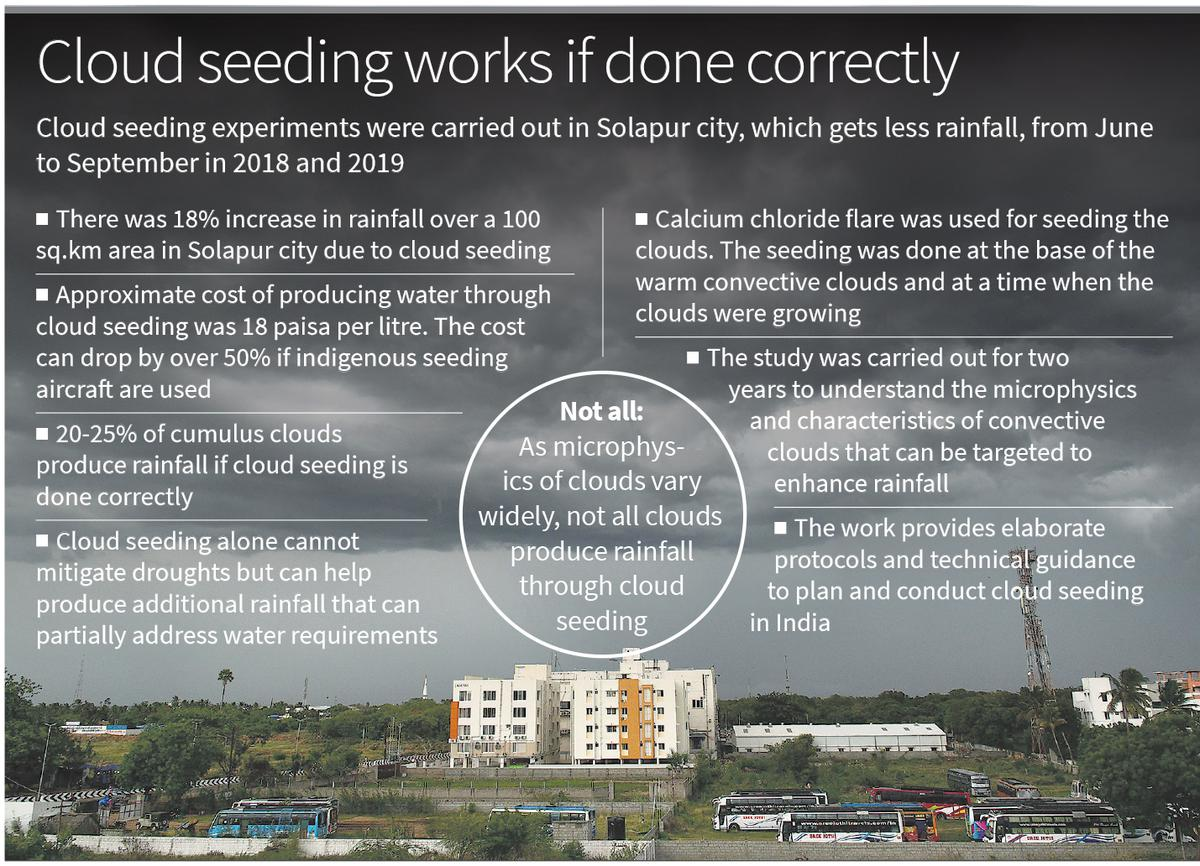Cloud Seeding to Reduce Air Pollution | 26 Nov 2024
Why in News?
Recently, the proposal for cloud seeding as a measure to combat air pollution in Delhi has gained attention due to the acute air quality crisis with the Air Quality Index (AQI) exceeding 450.
What is Cloud Seeding?
- About:
- Cloud seeding, a weather modification technique, enhances precipitation by dispersing chemicals like silver iodide, potassium iodide, or dry ice into clouds, which serve as nuclei for water droplet formation, leading to rainfall.
- This process facilitates the formation of ice crystals in clouds, which can lead to artificial rain.
- The technique is being considered as a potential solution to combat severe air pollution, particularly during periods of high Air Quality Index (AQI) readings.
- Types of Cloud Seeding:
- Static Cloud Seeding:
- This method involves introducing ice nuclei, such as silver iodide or dry ice, into cold clouds that have supercooled liquid water droplets.
- The ice nuclei can trigger the formation of ice crystals or snowflakes, which can grow at the expense of the liquid droplets and fall as precipitation.
- Dynamic Cloud Seeding:
- Dynamic cloud seeding is a technique to artificially stimulate rainfall by enhancing vertical air currents, thereby promoting the formation and growth of rain clouds.
- The process is considered more complex than static cloud seeding because it depends on a sequence of events working properly.
- Hygroscopic Cloud Seeding:
- This method involves spraying fine particles of hygroscopic materials, such as salts through flares or explosives into the base of warm clouds.
- The particles can act as cloud condensation nuclei and increase the number and size of the cloud droplets, which can enhance the reflectivity and stability of the clouds.
- Glaciogenic Cloud Seeding:
- It involves inducing ice formation in supercooled clouds by dispersing ice nuclei such as silver iodide or dry ice, leading to ice nucleation and precipitation.
- Static Cloud Seeding:
- Applications of the Technique:
- Cloud seeding is also used to enhance winter snowfall and increase mountain snowpack, supplementing the natural water supply for nearby communities.
- Cloud seeding can also be done to prevent hailstorms, dissipate fog, induce rainfall in drought-prone regions, or reduce air pollution.
What are the Challenges in Implementation of Cloud Seeding?
- Environmental Impact: As artificial rain falls, seeding agents like silver iodide, dry ice or salt will also fall.
- Residual silver discovered in places near cloud-seeding projects is considered toxic. As for dry ice, it can also be a source of greenhouse gas that contributes to global warming (carbon dioxide).
- Temporary Relief: While cloud seeding may provide short-term relief from air pollution by washing away particulate matter, it does not address the root causes of pollution such as vehicular emissions and industrial discharges.
- Example: Cloud seeding in Lahore, improved AQI from "poor" to "moderate." However, the effects were short-lived.
- Availability Issues: Cloud seeding requires the presence of moisture-filled clouds, which are not always available or predictable.
- Specific cloud characteristics, including liquid water content and vertical motion, were used to identify clouds with potential for rainfall.
- Costly: It involves processes such as delivering chemicals to the sky and releasing them into the air by flare shots or aeroplanes, which involves huge costs and logistic preparation.
- Example: Cloud seeding in Delhi requires Rs 13 crore to cover the entire aerial area of 1,300 square kilometers.
UPSC Civil Services Examination, Previous Year Questions (PYQs)
Prelims
Q. In the context of which of the following do some scientists suggest the use of cirrus cloud thinning technique and the injection of sulphate aerosol into stratosphere? (2019)
(a) Creating the artificial rains in some regions
(b) Reducing the frequency and intensity of tropical cyclones
(c) Reducing the adverse effects of solar wind on the Earth
(d) Reducing the global warming
Ans: (d)

.png)
